From Brent to Bowl
21 community recipes to cut waste from your kitchen

21 community recipes to cut waste from your kitchen
In 2021 Veolia, in partnership with Brent Council, hosted a competition for our local communities to share their favourite planet-friendly recipes. In response we received a range of delicious dishes that represent some of the wonderful diversity and cuisines that we have in our borough. Each of the 20 winning entries showcased in this book tells a unique story of heritage, community and tradition, and collectively they exemplify Brent’s unique identity.
The four sections of this cookbookFamily Favourites, Time Saving, Special Occasions, and Something Sweet - are packed full of foodie tips to help you waste less food and save money.
The best mangoes from India and Pakistan are sold in Kingsbury. This is my favourite part of Brent! You can also grab the most authentically delicious Caribbean food, Eastern European delicacies, Middle Eastern favourites, Somalian produce and so much more.
The variety of fruit and vegetables available in the greengrocers in the borough indicates the diversity of the population of Brent. This is a borough which has two iconic temples - the Swaminarayan Mandir at Neasden and the temple of football, Wembley Stadium.
The recipes in this book from vegan muhalabia, Dorset mother-in-law cake, jollof rice to leftover ratatouille tell the food stories of people from different heritages, and their eco-friendly traditions. These meals are an integral part of the identities of people who live in Brent. This is their bridge to others. In sharing their recipes, they open their kitchens and their hearts to each other.
Founder of the Darjeeling Express restaurant, Covent Garden, and featured on Netflix’s Chef’s Table

From Brent to Bowl 2
We are also proud to feature the final recipe donated from the Great British Bake Off winner, Nadiya Hussain (page 46). Nadiya encapsulates the ethos of this book in her desire to tell stories through food, and her pride in being shaped by her unique cultural and societal upbringing.

I am delighted to write this foreword for a book that not only focuses on reducing food waste and protecting the environment, but is also a celebration of diverse communities and what makes Brent such a dynamic place.Credit: Chris Terry
This cookbook contains delicious recipes that have been lovingly shared by amateur cooks and residents from around Brent – not by trained professionals.
To the best of their knowledge each recipe outlines key allergens and instructions to prepare the dish in a safe manner, however it is still advisable that you take care when preparing any of these dishes yourself.
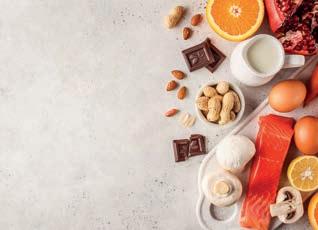
Please follow all normal food hygiene guidelines, ensure all food is thoroughly cooked through before serving and take caution if you suffer from food allergies. Veolia and Brent Council do not take responsibility for any sickness or injury resulting from anyone preparing food from this cookbook.
For guidelines on good food hygiene practices please visit www.food.gov.uk/food-safety
Food waste is a serious issue, and refers to food which is fit to eat, but for whatever reason doesn’t get eaten and is thrown away. In the UK, we waste 6.5 million tonnes of food every year, 4.5 million of which is edible. Those 4.5 million tonnes are enough to fill Wembley Stadium at least nine times over! The process of growing food involves the use of water, chemicals and land. It often comes wrapped or packaged in plastic, which is created from fossil fuels. Food also frequently needs to travel to reach us, which has an environmental impact regardless whether it comes by plane, boat, lorry or car. It is therefore imperative that we use every last piece of food we buy. We can all do our bit to tackle climate change through reducing the amount of food waste we create. Remember, although actions on your own may seem small, everything contributes – and if everyone took small steps each day, we would be one-step closer to solving the climate and ecological emergency. Below are some easy changes you can make to save money and cut down on food waste.
Planning and preparing your ingredients and meals for the week can save you time, money and cut down the food waste.
Before you put together your shopping list, check your cupboard and your fridge. When you make the week’s plan, don’t plan to cook every night, set aside a day or two to use up leftovers or make a new dish with leftovers (there are some great recipes in this book!)
You can save time in the week by preparing meals for the next few days and heating them through when you need to. Rethink your leftovers before you throw them away and save money too, for example:
- bread can be frozen or stale bread can be made into breadcrumbs.
- Fruits and vegetables can be frozen or turned into smoothies. Remember you can always freeze food before the use-by date. Defrost when you need it and use within 24hours.4
Is your fridge temperature below 5°C? Only 45% of the UK know that fridges should be set to 5 degrees or less.2 Storing food in a fridge at the correct temperature can add, on average, 3 additional days of storage life.3
In UK homes, just lowering the average temperature of fridges could save over 50,000 tonnes of milk that might otherwise have gone off1. There are many great tools online that can help you know what exact temperature your fridge should be, based on brand and model. Search ‘Chill the Fridge Out’ to find what the right temperature is for your fridge.
Storing our food in the right places is an easy way to reduce food waste and save money. Have a look and see what small changes you can make at home or during your next shopping trip to be more sustainable:
• Fruit and veg are best kept in the fridge with a few exceptions. Bananas and pineapples should be kept out the fridge but in a cool place; potatoes and onions should be kept out of the fridge in a cool, dark place like a cupboard4
• Celery, potatoes and carrots can be cut and stored in water for a prolonged lifespan. Changing the water every few days can make it last even longer. This can also be applied to avocados and apples
• Cheese & ham; opened packets should be well wrapped by re-closing the pack, wrapping in cling film or foil, or putting it in an airtight container. TOP TIP: save plastic by using beeswax wraps4
• Bread is best kept in a cool dark place such as the bread bin or store cupboard. You can also make bread last longer by freezing it. Did you know it takes 10 months to grow wheat for our bread, yet in the UK 20 million whole slices of bread are thrown away every single day.
Understanding the different labels can be confusing but it’s one of the easiest ways to reduce the amount of food we waste at home. Here are some of the most important ones to note:
• A use-by date is about food safety and is on food that goes off quickly, like meat or dairy. Do not freeze, eat or drink any food after its use-by date as it may be unsafe.
• Best-before date (sometimes shown as BBE) only relates to food quality5. It’s safe to eat after this date, but the flavour or texture might not be the best
• Egg shells - scatter around your garden plants as a deterrent for slugs
• Bones - boil them down to make a lovely stock or soup base
• Used coffee grounds and tea leaves make a great fertiliser for your garden, herbs or house-plants.
Some food waste is unavoidable - you don’t want to eat the skin of your pineapple. But the vast majority of our food waste is avoidable, the last few slices of bread that have gone stale, the forgotten spinach tucked away at the back of the fridge. It is this avoidable food waste that we want to cut out.
Avoidable food waste5 – food and drink thrown away that was, at some point prior to disposal, edible (e.g. slice of bread, apples, meat)
Possibly avoidable – food and drink that some people eat and others do not (e.g. bread crusts), or that can be eaten when a food is prepared in one way but not in another (e.g. potato skins).
Unavoidable – waste arising from food or drink preparation that is not, and has not been, edible in normal circumstances (e.g. meat bones, egg shells, pineapple skin, tea bags). You can recycle your unavoidable food waste in your food waste caddy.
1Our waste, our resources: A strategy for England: https://assets.publishing.service.gov.uk/government/uploads/system/uploads/attachment_data/file/765914/resources-waste-strategy-dec-2018.pdf
2Make your food last longer by storing them correctly: https://wrap.org.uk/resources/report/life-under-covid-19-food-waste-attitudes-and-behaviours-2020 Life under Covid-19: Food waste attitudes and behaviours in 2020 (26.02.21) 3https://wrap.org.uk/sites/default/files/2020-12/Impact-of-more-effective-use-of-the-fridge-and-freezer.pdf | 4https://www.lovefoodhatewaste.com/article/love-your-fridge-and-waste-less 5https://www.food.gov.uk/safety-hygiene/best-before-and-use-by-dates | 6https://wrap.org.uk/resources/guide/waste-prevention-activities/food
Hi, I’m Steve, a Cornishman living in Brent.
I’ve been here for about eight years now, coming up after graduating to work in advertising. When I’m not working, you can find me playing 5-a-side football, walking in the lovely Gladstone Park, oh, and cooking of course. Back when I was little lad, I’d go to my Granny’s house and bake pasties with her. Ever since then, I’ve had a love of making these Cornish treats for family and friends. But pasties, traditionally full of beef, aren’t that great for the planet, so I set about making a plant-based one, and here it is. They’re still just as tasty, and the best bit is that you can even use veg that’s going a bit old and also freeze them, so there’s no waste. There is just one rule though –they must be enjoyed over good conversation with family and friends.

(for four pasties)
Vegan puff pastry sheet
(available in most supermarkets)*
225g potato, peeled and diced into 1cm cubes
125g swede, peeled and diced into 1cm cubes
100g onion, peeled and diced
4 tbsp dairy-free margarine
150ml vegetable stock
1 tsp onion powder
1 tsp of dried thyme
20g cornflour mixed with water to form a paste (approx 20ml)
30ml oat milk
Preparation time: 20 mins Cooking time: 40 mins
Preheat your oven to 190C
Combine the gravy ingredients (veg stock, onion powder, dried thyme and cornflour mix) into a small saucepan and whisk until it has reduced and become thick. Once it has thickened, take off the heat.
Roll your pastry so it’s 1cm thick and use a small side plate as a guide to cut out four circles
Add your vegetables on one half of each circle, then add three teaspoons of the cold gravy over the top (evenly spaced) and two teaspoons of dairy-free margarine per pasty
Brush a little oat milk around the edges of the pastry and fold it over. Crimp the edges by folding them over slightly.
Cut three air holes in the top of each pasty and brush the top with the oat milk.
Put your pasties in the hot oven and cook for approx. 40 minutes. They should be ready when they are golden all over, including the base.
Allergens: *Contains gluten

It’s plant-based. It can be made using veggies that are about to go off, and you can even use the veggies you have kicking about in the fridge rather than buying the specific ones the recipe asks for! They freeze really well, so you can eat them when you’re ready without worrying about shelf life. Last but not least, because the veggies are covered by a blanket of pastry, you can use all the wonky and mis-shaped veg because no one will see!
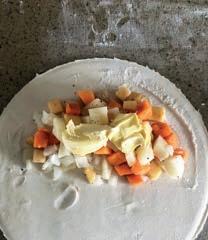
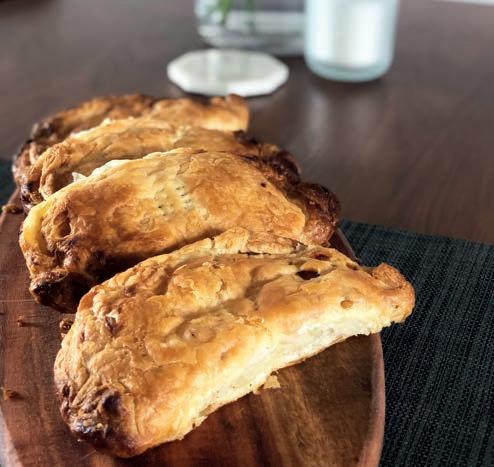 From Brent to Bowl 7
From Brent to Bowl 7
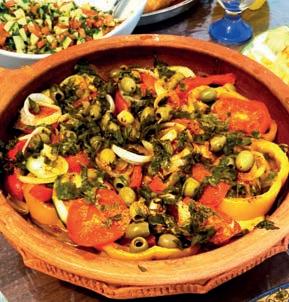
I was born and raised in Morocco and have been living in Brent since I relocated from my home country 6 years ago. I love being part of this multicultural borough. Growing up with Moroccan cuisine, I developed a passion for delicious food using different organic spices and ingredients. In Morocco, where I grew up, making a tagine meant that the whole family would be gathered around the table, eating from the same plate, and having a chat and a laugh about how our days had been. It’s the lovely smell of all the vegetables that we saved from going to the bin as we clear the fridge for the next shop.
Preparation time: 15 minutes
Cooking time: 45 minutes
If it’s the end of the week and you have different veg left in your fridge which might otherwise go to waste, a tagine (a clay pot) will come to your rescue! Clean and cut any vegetables you have and use these in your tagine!
1tsp Salt
1tsp black Pepper
1tsp Turmeric
1tsp ginger powder
Grated fresh tomatoes (2 tomatoes)
1 onion
Harissa (Moroccan Chilli sauce)
if available (1/2 tsp)
Parsley (1 tbsp)
2 cloves garlic
Olive oil or argan oil

Green olives for decoration and extra taste
For best results use a clay pot or a casserole dish
Heat the pan on a medium heat. Add oil, then add the chopped onions
Wash and cut all vegetables into circles and add them to the clay pot (pan)
Mix all spices with the garlic, parsley, harissa, grated tomatoes and a little bit if water, and pour the mixture over the vegetables
Put some olives on top
Cover the clay pot and let it cook on low gas for 45 minutes or until the vegetables are tender.
I have lived in Brent over 20 years, and am currently an Artist. I have 3 children aged between 13 and 21 years old. I love to cook for the family and have been trying to encourage the children to have a healthier eating lifestyle! This dish is a vegan take on a traditional Jamaican dish. I feel it is important for the children to recognise their cultural background, as well as give them a healthy food choice, and this dish does both!
(Makes 4 servings)
1 cup of red kidney beans (soaked overnight with 3 cups of water and garlic)
6 Cloves of Garlic
1/2 an onion
4 green onions
1 tsp allspice
1 large carrot
1 whole scotch bonnet pepper
1 tbsp frozen ginger
Preparation time: 20 minutes Cooking time: 1 hour
Drain the pre-soaked beans and garlic then add about 1 and a half cups of water on a medium heat. Bring to the boil, add the onion, thyme, allspice and all purpose seasoning, and keep checking to see if you need to add anymore water.
The recipe is a vegan version of a dish that typically uses some form of meat. I would advise shopping at greengrocers to avoid all the plastic packaging you get at most supermarkets. Make sure you keep, wash, clean and reuse any glass jars that your ingredients may come in. If not, remember to recycle them!
Some of the ingredients used are pre frozen, such as the ginger, coriander and thyme. Any flour not used after rolled out, is frozen and any stew not used, is cooled, then frozen for another time. Unused herbs and vegetables are saved and kept in the fridge for future dishes. Nothing is wasted!
Allergens: *Contains gluten
Couple sprigs of thyme
1/4 red, yellow and green bell peppers
4 cups of canned coconut milk
5 cups of water
1/2 tsp all purpose seasoning
Black pepper
2 vegetable stock cubes
FOR THE SPINNERS (DUMPLINGS):
1 and 1/4cups of spelt flour*
Add water until you create a firm dough
To make the Carribean dumplings (spinners) slowly combine the flour and water in a bowl. Knead it together for 3-4 minutes until you get a simple, soft dough and leave it rest for 20 minutes. Then just tear off pieces of the dough and roll them with your hands into small sausages (about 2 inches long).
Add 3 cups of coconut milk to the beans.
Add the ginger and stir continuously. Then after 5 minutes add the spinners, bell peppers, carrots, the rest of the coconut milk and stir.
Add the thyme and scotch bonnet pepper, stir properly.
Crumble in the vegetable oxo cubes.
Season with black pepper
Let the dish simmer, and cover the pot and continue to stir and let thicken.
Remove thyme stems before serving
This dish can be served with plain basmati rice, callaloo, plantain or on its own.

 Hi, I’m Jacqueline.
Hi, I’m Jacqueline.
I am the inspiration behind Mama Jacq’s. I was born on a small Caribbean island called St. Vincent & The Grenadines, one of 7 children. I grew up in a family where cooking was the centre of all family activities and events. I was very close to my mother before she passed, she spent a lot of her time in the kitchen. In fact all of our ingredients are highly influenced by recipes
1 red bell pepper
1 yellow bell pepper
1 green bell pepper
1 onion
4 grated cloves of garlic
1 chicken stock cube*
3 vegetable stock cubes*
1/4 cup mixed herb
2 tsp black pepper
1/4 cup curry powder*
1 tin of 400g Tomato puree
1800ml water
1 hot whole scotch bonnet pepper
1 tsp all purpose seasoning
2 tbsp of honey
1 kg of jerk grill or baked chicken*
Allergens: Soya and celery in stock cubes, soya in jerk marinade, mustard in curry powder (may also contain traces of sulphur dioxide although it is not added as an ingredient)
handed down from generation to generation. I have had four children; Joshua, Jaydon, Chantal, and Dominic. Two of which play a vital role in running Mama Jacq’s Ltd. We didn’t have a lot of money growing up in the Caribbean and throwing away leftovers was out of the question. My mother always thought of unique ways to make dinner different from the evening before.
Preparation time: 15 mins Cooking time: 50 mins
Remove bell peppers from the seed. Slice all bell peppers diagonally and place in a bowl to pour into the pot later. Do the same for your onion. Grate garlic into a bowl with onion and bell peppers.
Add vegetable stock cubes, mixed herbs, black pepper, curry powder, all purpose seasoning to the bowl with bell peppers and onions.
Place the pot on medium heat, add 2 tablespoons of oil to the pot, then pour all ingredients in the pot. Stir for 2 minutes.
Add tomato puree, and water to the pot.
When mixture begins to boil add 2 tablespoons of honey and place jerk chicken in a pot.
Allow the mixture to simmer for 30 minutes, this will get all the seasoning from the jerk chicken into the tomato sauce. The chicken will begin to soften and become succulent with the sweet tomato sauce.
The last 10 minutes place a whole scotch bonnet in a pot. Do not cut the scotchbonnet, it is used simply for flavour and not for heat.
We recommend eating it with rice and steamed vegetables.
This dish uses leftover baked chicken. All we do is make a sauce and soak the chicken into the sauce, cooking it on medium heat for 10 minutes. Our dish uses locally sourced ingredients such as mixed peppers which are a key ingredient of the recipe. Why it’s good for the environment
 From Brent to Bowl 11
From Brent to Bowl 11
I have been living in Brent since 2010 and started to work closer to the local community between 2013-2014 when I had my first child. I currently work as coordinator of the Harlesden Neighbourhood Forum and deliver different projects for families, children and young people with different organisations across Brent. As a lifelong member of the girls scout and girls guide movement I love the outdoors, green spaces, cooking, developing ideas with my children and exploring new places.
Cooking has a long tradition in my family back in Southern Italy and I am definitely carrying on everything my parents taught me. My father has an orchard back in Italy and my mum used to cook what he brought from the garden. When I was little my parents

(Makes 6 servings)
2 tbsp extra-virgin olive oil
2 leeks, halved, thinly sliced crosswise (you can use carrots or courgettes if you do not have leek)
1 medium onion, halved, thinly sliced Salt, freshly ground pepper
2 potatoes (if you have them boiled from the day before as leftover, even better)
1 tsp ground cumin
½ tsp cayenne pepper
½ tsp ground turmeric
3 handful of green peas (fresh or frozen)
did not have a steady job, so saving and eating properly was the foundation of our life at the time. The spring soup was quite famous, because in spring we had a big amount of peas, potatoes, onions and courgettes with their flowers. I do the same now. My children have eaten soups of all kinds since they were babies. The Mediterranean diet comprises a lot of vegetables and cereals. Despite what people think abroad in Italy we do not eat pasta and tomato sauce or pizza everyday! On the contrary, we appreciate the diversity and creativity that legumes and vegetables can offer. We have had a long connection with northern African countries in southern Italy, hence we use a lot of spices because they were imported centuries ago.
Preparation time: 15 minutes Cooking time: 35 minutes
Pour the oil in a large pot and add all the vegetables sliced. Add salt and pepper and cook on a medium heat for 10 min, mixing now and then.
Add cumin, cayenne, and turmeric to the pan and stir to combine. Add peas and stir to coat; season with salt.
Stir in 6 cups of water and simmer for 20 minutes. Add more water as necessary.
Once ready use a food processor to puree it. (Depending on taste you can have half puréed and the rest in hard pieces).
If you have leftover bread, pita or wraps, cut them into strips or pieces, mix with oil, salt and smoked paprika and bake them in a tray for ten minutes. They will be a great addition to your soup.
If you want you can add tiny pasta shapes or rice instead of bread.
Serve piping hot and enjoy!
Very often vegetables are left in the fridge or cupboard and if not used on time might rot. This soup is a great way to use these before they go bad. Also once cooked you can freeze the leftovers. At the end of the week is when I check what is left and start to prepare delicious soups. Furthermore, it is completely plant based, it is low cost, and easy to prepare.
If global annual emissions from food waste, some 3.3 billion tonnes were released by a single country, that nation would be the world’s third largest polluter behind China and the United States1

It has been 23 years since I have lived in Brent and I worked there for 12 years. At present, I work for Brent Council’s Executive and Member Services department. I am a full time working wife and a mother of three. I am so lucky that I am still able to find the time to cook, bake, create, experiment with new food and recipes. My children and husband enjoy it too! Cooking has always been a passion of mine since the age of eight. I was born and raised in The Gambia, a small West African country once colonised by Great Britain. My favourite dish on the African continent is Jollof rice or Benachin - meaning one pot, a dish eaten mainly in West Africa but cooked differently according to region. That is where I started perfecting the method of combining Senegalese and Gambian techniques to make my perfect Senegambian Jollof Rice.
(Makes 6 servings)
6 chicken legs (or 1 medium whole chicken cut into 6 portions)
2 cup Vegetable oil

1kg basmati rice (5 cups) wash three times using your hands to scrub the grains together.
8 cup Water
2 medium fresh tomato, 1 large onion, 5 cloves of garlic (chop finely or put all in a food processor and blitz)
2 level teaspoon ground black pepper
Salt to taste (2 chicken stock cube optional)
5 tablespoons tomato puree
Any vegetables of your choice2 Bay leaves
1 Aubergine
4 cup of rice
Optional: 1 Scotch bonnet, also known as bonney peppers, or Caribbean red peppers
Having a healthier eating style, I enjoy food that is full of goodness and fresh ingredients; I like consuming foods that are good for me and for my body and mind, so I have reduced a lot of fats and salt in the preparation of this dish. This dish has several variations in The Gambia, Senegal, and other neighbouring countries. Sacred Jollof rice is one of the most revered dishes in West Africa for its delicate sweetness and mild spicy flavour, simmered in reduced tomatoes, onions, peppers, and different seasonings depending on where it is made. It is an iconic dish, with massive regional significance across West Africa. It is a persistent real-life argument over which African country makes the best version of the dish.
Preparation time: 30 mins Cooking time: 2 hours
Clean chicken leg thoroughly with salt and vinegar (cut whole chicken into 6 pieces).
Lightly season the chicken with salt, vinegar and ground black pepper or any spice of your choice, leave to marinate for 10 minutes or more, your choice.
Finely chop the onion, tomatoes, Marconi red sweet pepper and garlic cloves or put all in a food processor and blitz) then set aside.
In a deep 3-litre pot, add the oil and heat. When hot, fry the chicken in the vegetable oil until both sides are brown. Remove and set aside.
Add tomato puree to the hot oil and brown for 10-15 minutes or until the colour is dark brown and the paste is now separated or looking like tiny grains, without burning the paste. (To achieve this you need to keep adding 2 tablespoons of water every minute and continuously stirring to avoid it not sticking on the bottom of the pan or burning).
Add the finely chopped onions, fresh tomato, sweet pepper and garlic to the hot tomato paste and cook for 5 minutes. (Keep adding drops of water to help with the browning without burning). Add 1 teaspoon of salt at this point.
Pour water and bring to a boil, then add the fried chicken, all the vegetables, bay leaf and (scotch bonnet optional) add seasonings, (teaspoon of salt or two chicken stock cube) and simmer for 10 minutes. (5 minutes for the vegetables to avoid over cooking the vegetables, remove and set aside)

Remove all the chicken pieces and vegetables and set aside. Remove 2 cups of the sauce out and set aside (use this instead of plain water if you need to add more water to the rice later if the rice is still hard), you can also use it as a gravy poured over your Jollof Rice when eating. Which is very nice.
Add the washed rice while continuously stirring. Tip: Reduce cooking time by steaming the washed rice in a steamer or microwave. Reduce heat and cover the pot. Simmer for 10 minutes.
Open the pot and turn the rice and mix thoroughly, cover and leave to cook on low heat for another 10 minutes or until the rice is soft and fluffy.
Serve on a plate with some chicken and vegetable and garnish with scotch bonnet (hot pepper - optional)

Chef notes:
If vegetarian/vegan, follow steps 5-12. There are a few other ingredients we also use like cassava, pumpkin, okra boiled with the vegetables in the sauce, authentic spices and dry snail from the Gambia which are not readily available in the UK. If you can source them, why not include them in?
The spread of Jollof, also named Benachin, meaning “one pot,” meant that regional changes also influenced differences in the recipe. My dish is good for the environment as everything is cooked in the same pot, which saves the amount of energy and water needed to cook the dish. Why
By loving your leftovers, you can save yourself a lot of money, whilst also saving a huge amount of food from going to waste!
We can either refrigerate or freeze leftovers to save them for another day, or turn them into a whole new meal! Challenge yourself to dedicate one evening each week to make a meal entirely out of leftovers.
Leftovers are great because:
• They are already cooked!
• Don’t feel like cooking lunch or dinner? Don’t worry, leftovers will sort you out
• They are versatile!
• You won’t get bored of the same meal again and again - soup can be turned into a pasta sauce and stale bread makes the perfect breadcrumbs to top the pasta!
Small, independent shops and businesses have been hit hardest by the lockdown, and need our support more than ever. These shops are also more likely to sell local produce or stock the harder to find items that you will find in this book.
Across Brent you will find huge a range of fantastic independent shops and markets that are too many name. The individual shops listed below are a few that have been recommended by the residents that feature in this book.
• Alwan Supermarket, Kingsbury
• Munroes, Cricklewood
• All Seasons, Preston Road, Wembley
• Queens Park Farmer’s Market, Queens Park
• Big Ben, Harlesden High Street
• Willesden Market (Wed & Sat), Willesden
• Numerous shops for South Asian food and groceries, Ealing Road, Wembley
• Eastern European Food and Wine, Harrow Road, Wembley
• Various shops ranging from Turkish to Polish to Asian, Neasden Parade and High Street
• MIR Food Centre, 451 Kingsbury Rd, London NW9 9DY
Shop Safe, Shop Local is an initiative by Brent Council to help local people to discover the wonderful shops on their doorsteps. Find out more at brent.gov.uk/shopsafeshoplocal
From Brent to Bowl 16
There are many things that we can do to reduce our carbon footprint when it comes to our food consumption. Becoming aware of your eating habits is the first and biggest step you can take. Once you are thinking about what you consume, you’re on your way to becoming a sustainable eater! If you want to go that step further, have a look through our checklist and see what else you can do.
Eat more plant based meals - start by going meat-free one day a week and build up!
Eat local produce where possible. Eating local produce significantly reduces the environmental impact of our meals by cutting down air and shipping miles. It also supports local businesses!
Choose fish and meat from sustainable sources.
• If you can, buy organic, free range meat, eggs and milk.
• Beef and lamb have the highest carbon footprints of all meat due to the methane they produce during farming. You can make a big difference by cutting down the amount you eat. For more information on the carbon footprints of different foods visit: https://ourworldindata.org/food-choice-vs-eating-local
• Look out for a reputable accreditation on the packaging
• Check out The Good Fish Guide (www.goodfishguide.org) for the latest information on sustainable fish. You can download their app for free
Look out for wonky veg - these are often cheaper and are more regularly wasted, but are just as good!
Eat seasonal
Check out the seasonal fruit & veg calendar on page 29
Grow your own
What better way to cut mileage and eat the freshest fruit and veg you can find than growing your own? That doesn’t even include how much better food tastes when you have grown it yourself. Check out the following local growing projects:
• Feed Me Good - Harlesden
• Mutual Aid local food growing projects
Propagating
Propagating your vegetables is a great and easy way to get into starting your own vegetable garden!
Propagating is regrowing plants from the parts that would usually be scraps - the base of your lettuce or spring onions that you might normally recycle will be the start of your next meal!
For lettuce such as romaine, cut off the base, place it in a shallow bowl with ½ an inch of water. Change the water every day and see your new vegetable grow!
My love of food has developed from being a doting mother and wife, and always wanting to give only the best for my family and loved ones. My heart goes into the variety and intricacy of Indian food. I have spent my life developing and refining traditional Indian dishes, taking knowledge from all over the world and cleverly incorporating it into my own dishes. I have never been a keen reader most of my life, but you will always see me pick up and read a recipe book. My profession has been a childminder for over 35 years, and more recently I have my own catering business called ‘momzkitchen’.

Preparation time: 10 mins Cooking time: 30 mins
It’s a healthy dish and more importantly the remaining kale from what would have been wasted is added instead of throwing it away!
1 cup kale
1/2 cup gram flour
1/2 cup semolina
3 tbsp plain yogurt*
1 tsp minced ginger/ garlic
Salt to taste
A pinch of red chilli powder
A pinch of sugar Oil
1 tsp Eno (if you don’t have Eno try using 1tsp bicarbonate of soda)
2 tbsp oil
1/2 tsp mustard seeds*
Add all the spices, oil, flour and yogurt to the kale and mix well.
Fill the base of a steamer with water, cover, bring to boil and simmer on low heat.
Add 1 tsp Eno into the kale mixture and mix well. The Eno should be bubbly. If not, add a few tablespoons of water and mix well.
Grease a deep 9 inch plate, add all the kale mixture and steam for 20 mins.
After 20 minutes, allow to cool and cut into squares. In a frying pan heat oil and add mustard seeds and then add spicy cake dhokra. Cook until crispy - serve hot or cold.
Allergens: *Contains common allergens milk, mustard

Why it’s good for the environment
Why it’s good for the environment


I am a mum of one and have lived in Brent for 17 years. I have a real passion for cooking and I love walking around Welsh Harp! This recipe was developed during the 1st lockdown with my autistic son who’s enjoyed every single bit of this process.
(Makes 6 servings)
Prep time: 20 minutes Cook time: 20 minutes
Preheat the oven to 180oC.
2 cups cooked rice that has been refrigerated (do not reheat rice that is older than 1 day old)
3 eggs
Vegetables - any leftovers you have!
1 cup milk*
Cheese (to your liking)*
Salt and pepper
Mix ready cooked rice with one egg and place in a tart tin. Shape the rice to the base of the tin. The rice will form our base. Note: reheating rice can be dangerous to eat if it is not cooked through properly. Make sure that the rice is steaming hot and cooked all the way through before eating it- do not reheat rice more than once.
Chop all of you r vegetables and place them on top of the rice ‘base’.
Mix one cup of milk with two eggs. Season with salt and pepper and pour over vegetables.
Top with your choice of cheese.
Bake for 20 minutes.
This dish is designed to use up any leftover veg that you have. Each time you make it, it will be slightly different and I love that!
Allergens: *Contains milk
From Brent to Bowl 19
Hi, I’m Nisha.

I have lived in Brent for 32 years. I was born and raised in lovely Wembley. I am a civil servant and I love what I do!
In my spare time, you will catch me at the gym, learning how to DJ (my husband’s a DJ) and most importantly, cooking! I am always the first person to put my hand up and offer to cook for parties! Growing up around my wonderful mother and aunties, who are superb cooks, has always inspired me to be just as good. I enjoy trying out different cuisines but my favourite are Indian and Caribbean dishes. It doesn’t matter what day of the week it is or how tired I am, I have to cook fresh food everyday. I also strongly believe in zero waste cooking and always use any leftovers the following day. Hope you enjoy my recipe!
(Serves 2)
1kg baby potatoes
1x400g tin of Baked Beans
1 cup of sweetcorn (you can add 2 if you love sweetcorn)
1 or 2 red onions (depending on your taste buds I use 2)
3 vegetarian sausages cut into pieces
Sprinkle of mixed herbs
Sprinkle of thyme
3 tbsp olive oil
Salt to taste
Pepper to taste
Chilli flakes (optional, put 2 teaspoons if you like a kick)
Cheese of your choice and cheese quantity of your choice, grated (I use 250 grams of mature cheddar)*
Allergens: Contains milk
Prep time: 10 minutes Cooking time: 30 minutes
Wash the potatoes. Parboil in a saucepan with a pinch of salt for 7 to 10 mins. You can check that they are almost cooked by piercing with a knife. Drain using a colander and put into an ovenproof dish. Skip this stage if you’re using leftover roast potatoes / baby potatoes.
Toss the potatoes with olive oil, pepper, thyme, and salt. Cook for 10 mins at 180oC in a preheated oven (cook for 5 mins in a preheated oven if using leftover potatoes).
Take the oven dish out safely using oven gloves. Shake the potatoes in the ovenproof dish and top with baked beans, sweetcorn, red onions and cheese. Sprinkle with mixed herbs and chilli flakes.
Put the dish back into the oven (180oC) and cook for a further 8-10 mins. I like my cheese brown so I take mine out once the browning effect on the cheese has occurred.
Once the cheese has browned, take the dish out of the oven and let it stand for around 5 to 7 mins. This will ensure the dish is settled and ready to serve.
Enjoy! Chilli lovers you can go ahead and add green chilli pieces or hot pepper sauce!
This dish prevents waste by using the leftovers from either Sunday Roast or an English breakfast.
I find sometimes my potatoes are going off and to keep them fresh I generally parboil and freeze. You can parboil pieces, mash them up or cut them into chips and freeze.

The dish is plant based - using baked beans, potatoes, onions, sweetcorn and vegetarian sausages. It is full of protein and absolutely delicious!

https://wrap.org.uk/resources/report/life-under-covid-19-food-waste-attitudes-and-behaviours-2020
Only 38% of us see a clear link between wasting food and negative impacts on nature (e.g. deforestation, habitat loss)2
I have always lived in Brent and I work in Brent as a health and safety professional. I started cooking before I turned 10 years old. In my culture in Kenya, it was very important at the time that girls were first taught how to cook and run a household. Initially I would only get a chance to cook in the evenings and weekends. Most evenings, my mother would use the left overs from lunchtime to make the evening meal. Lunchtime meals were the main meal of the day. Often we would have leftover rice so in the evening mum would increase the quantity by adding whatever vegetables were available. As I grew older I learnt how to make very nice and tasty dishes out of whatever was available and over the years I mastered how to make new dishes from leftovers. Nothing is wasted or thrown in our kitchens.
(Makes 4 pasties)
Leftover cooked rice - around 1 cereal bowl’s worth- that has been refrigerated (do not reheat rice that is older than 1 day old)
1 cup frozen, tinned or fresh chopped vegetables i.e. potatoes, carrots, peas, sweet corn or cubed potatoes
½ teaspoon cumin seeds
½ chopped onion
1 tablespoon oil
Salt to taste
½ teaspoon Turmeric
Chilli powder to taste (optional)
Often, my non-Gujarati friends and colleagues often say that I can make a banquet from very little! Some of these friends and colleagues have even come over to me to learn how to make simple things and usually use leftovers.
I love entertaining and also give food to older folks who are not able to cook much. During the pandemic I did a lot of the cooking and took it to people who were self-isolating or not able to go out to get their own food or cook.

This dish is tasty, nutritious, filling and most importantly, nothing is wasted. It is also very much a reminder of my childhood days and brings my mother and father’s touch and taste to it.
Preparation time: 5 mins Cooking time: 15 mins
In a pan, heat the oil, and when warm add the cumin seeds and chopped onion. Fry until slightly golden.
Add the vegetables, salt, turmeric and chilli powder and simmer for 5 minutes or until vegetables are cooked.
Add the leftover rice, mix and shut the lid and let it simmer until piping hot and cooked thoroughly (approximately 5 - 10 minutes). Note: reheating rice can be dangerous to eat if it is not cooked through properly. Make sure that the rice is steaming hot and cooked all the way through before eating it- do not reheat rice more than once.
If you have chopped coriander, garnish before serving.
Serve with plain yogurt, salad or eat on its own.
Measure right to save money: one mug of dry rice will feed four adults once cooked (75ml100ml per person)

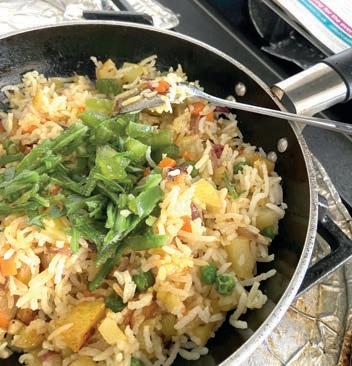
We have a few local shops on Preston Road, Wembley and my favourite is All Seasons as they are very much a local grocer. They know their customers have a wide range of vegetables for all cultures - ranging from English, Eastern European, Caribbean, Asian, Indian etc. You can shop in one place for everything one needs.
From Brent to Bowl 23

I have lived in Willesden Green, Brent, for my whole life. I have just finished my BA degree in Government and Counter-terrorism, and I am so excited to kick-start my career in the homeland security field. I have also set a challenge for myself, which is to join the British Reservist army this year. My interests and passions lie in cooking, travelling, and playing badminton. Cooking has always been something that I loved to do since I was twelve years old. In order to improve my cooking skills, two years ago I had the opportunity to intern as a chef at the prestigious Dorchester Hotel in Central London.
1 bell pepper (you can use any colour. Cut into equal strips)
1 spring onion (evenly chopped)
1 block of tofu (evenly diced)
Teriyaki sauce (generous drizzle)*
5 tablespoons sesame oil
100g medium sized noodles
Sprinkle of black sesame seeds*
2 tablespoons worth of chopped coriander
This dish is special to me because it’s what I would always treat my friends with for dinner at university. Now that I have finished my studies, this dish always brings back a sense of nostalgia. One doesn’t have to be a vegan to enjoy this dish, and so my meat-eater and vegan friends can simultaneously enjoy my food without having to worry about dietary needs.
Allergens: *Contains common allergens, including sesame seeds
Preparation time: 10 mins Cooking time: 20 mins
Add 3 tablespoons of sesame oil to a wok on medium heat. Once the oil becomes hot, add in the diced tofu and fry until their sides become golden brown. Keep moving them around in the wok so that they do not burn.
Once the tofu has crisped up nicely, set aside on a plate. In the same wok, add in the remaining 2 tablespoons’ worth of sesame oil and sliced bell pepper. Sauté the pepper for 5 minutes and keep mixing it around the wok to avoid burning.
Whilst the pepper is sautéing, boil 500ml of water. Then, add it to a separate pot on a medium heat. When the water starts to simmer again, add in the noodles and cook according to packet instructions. Usually they should be ready within 5 minutes.
By now the pepper should be soft enough. Incorporate the crispy tofu and teriyaki sauce (a generous drizzle of it). Mix well on a medium-low heat for 4 minutes.
Once the noodles are done, strain and set aside. To avoid them getting dry and clumpy, you can add a touch of sesame oil and mix it in.
After frying the pepper and tofu with teriyaki sauce, turn off the heat and add in chopped spring onion. Adding the spring onion at the end makes the whole dish fresher and vibrant.
In order to plate, you can mix the noodles and wok ingredients together, or have the tofu and pepper mix lying on top of the noodles.
Serve immediately and add a sprinkle of black sesame seeds and chopped coriander all around.
This helps reduce food waste because you can use leftover noodles. This recipe is completely plant-based, and the tofu is the show stopper here! To make this dish even more environmentally friendly, you can swap out bottled teriyaki for a homemade sauce version, as well as sourcing vegetables from local farmers markets. Why it’s good for the environment
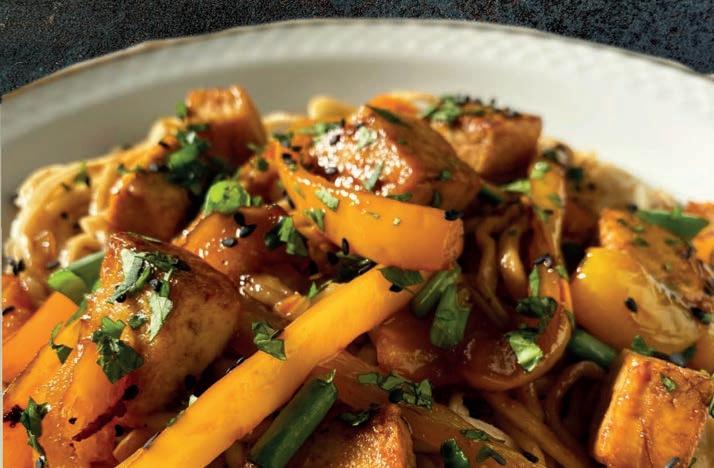 From Brent to Bowl 25
From Brent to Bowl 25
I have lived in Brent since 1996. I moved here from Birmingham and began a career working in the civil service before joining NHS England and Brent CCG. After taking a short career break, I changed direction and set up my own home based business producing ‘ready to eat’ cooking sauces. Food has always been at the heart of our lives! Whether cooking elaborate meals for family and friends or quick dishes for last minute guest appearances, it’s been a passion of mine to try different cuisines, methods and ingredients. So I ventured further and started my own business - Random Recipes.

1 cup corn oil for frying
200g potato fries (leftovers or pre-cooked)
1 tsp plain flour*
1 x 300g jar of masala saucefor example Random Recipes’
Makhani Masala sauce
1 fresh green chill
1 tbs freshly chopped coriander for garnish
Allergens: *Contains gluten
I absolutely love creating exciting meals but as time and energy are a very precious commodity these days, I decided to turn my passion into a business and help others to also create delicious meals regardless of background, skill, experience or timing issues.
I also wanted to promote ways to reduce food waste, recycle unusable leftovers and reduce daily expenditure. So I began this journey by combining my cooking sauces and introducing new ways of meal preparation!
Preparation time: 5 minutes Cooking time: 15 minutes
Finely chop/grind the fries into crumbs. Add flour and combine to make a dough-like mixture.
Divide the mixture into 8-10 sections and roll these to make small rounded balls.
Heat the oil in a suitable pan on a medium heat setting.
Gently add the balls and fry until evenly browned. Remove and place on kitchen paper to drain excess oil.
In a separate pan with lid, add masala cooking sauce and heat on low-medium heat. Add the fried potato balls.
Stir gently and cover balls with the sauce, lower heat setting, cover with lid and allow to simmer for 6-8 minutes. Stir gently and allow to simmer for further 2-3 mins.
Serve hot, garnish with green chilli and freshly chopped coriander. Serve with naan, rice or flatbread.
We always order too many chips with our takeaways, and so I created a dish which uses the leftovers - Malai Kofta! I added a few more ingredients, my own Makhni sauce and created a delicious meal within 10 mins! And the best bit? No one realised it was last night’s leftover fries!
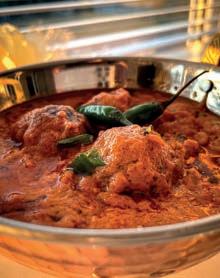
My top tip: the mashed, frozen chips mix is ideal for fillings for parathas, pakoras, last minute meals, as a thickening agent, stuffing and much more! No need to peel loads of potatoes and it reduces food waste further as no potato skins are discarded!
 From Brent to Bowl 27
From Brent to Bowl 27

By reducing your food waste, you reduce the amount of food which may end up rotting and releasing methane – a powerful greenhouse gas, even more powerful than carbon dioxide, which contributes to global warming, and subsequently to climate change. You can easily get rid of any leftover, unavoidable food waste using your food waste bin. It’s emptied weekly - twice as often as general waste bins from houses - and taken to a special anaerobic digestion plant. Here it gets recycled into soil fertilizer and helps make energy for the national grid, powering homes and businesses.
Always use a compostable caddy liner or wrap your food waste in a single sheet of newspaper
Plastic and food waste do not mix! Always use compostable food caddy liners, these can be purchased at your local supermarket.
Lock that lid!
• Your food caddies are specially designed to keep smells and vermin out by locking. Make sure you always remember to lock the lid of your food caddy.
If you live in a house remember to place your food caddy out next to your recycling bin before 7am on your collection day
• Empty this into your outdoor caddy as soon as it starts to get full so you never have to worry about mould or the smell!
Line
• If you have a caddy you can put newspaper or cardboard at the bottom to absorb any dripping liquid
If you live in a house and don’t have a food caddy order one for free at:
brent.gov.uk/recycling
• This is an inexpensive, natural process that transforms your food and garden waste into a valuable and nutrient rich food for your garden. Search “Home composting” at brent.gov.uk to order your own compost bin
Eating food which is grown closer to you is one of the best ways that you can reduce your own carbon footprint and support a more sustainable food economy. Buying your fruit and vegetables in season always tastes better, can support local growers, is often cheaper and reduces the amount of energy it takes to produce and transport. Everyone wins!
Below is a calendar of when best to buy fruit and vegetables so that they’re in season.
Fruit and vegetables seasonal calendar
January
- Apple
- Banana
- Beetroot
- Brussels
- Sprouts
- Cabbage
- Cauliflower
- Celeriac
- Celery
- Chestnut
- Clementine
-Dates
-Grapefruit
- Kale
- Leek
- Lemon
- Onion
- Orange
- Parsnip
- Pear
- Sweet Potato
February
- Apple
- Banana
- Brussels
- Sprouts
- Cabbage
- Cauliflower
- Celeriac
- Celery
- Clementine
- Grapefruit
- Kale
- Leek
- Lemon
- Onion
- Orange
- Parsnip
- Rhubarb
- Sweet Potato
- Turnip
March
- Banana
- Brussels
- Sprouts
- Cabbage
- Cauliflower
- Celeriac
- Grapefruit
- Leek
- Lemon
- Onion
- Orange
- Pak Choi
- Parsnip
- Pepper
- Pomegranate
- Rhubarb
- Sweet Potato
April
- Banana
- Cabbage
- Cauliflower
- Celeriac
- Grapefruit
- Lettuce
- New Potatoes
- Onion
- Pak Choi
- Peas
- Pepper
- Pomegranate
- Potato
- Rhubarb
- Spinach
- Spring
- Greens
- Water
May
- Apricot
- Banana
- Cabbage
- Carrot
- Grapefruit
- Lettuce
- Mint
- Nectarine
- New Potatoes
- Onion
- Pak Choi
- Peas
- Pepper
- Pomegranate
- Potato
- Radish
- Rhubarb
- Spinach
- Spring Greens
- Watercress
June
- Apricot
- Asparagus
- Aubergine
- Banana
- Cabbage
- Carrot
- Courgette
- Lettuce
- Mint
- Mangetout
- Nectarine
- New Potatoes
- Onion
- Pak Choi
- Peas
- Pepper
- Pomegranate
- Potato
- Radish
- Runner Bean
- Spinach
- Spring Greens
- Strawberry
- Tomato
- Watercress
July
- Apricot
- Banana
- Cabbage
- Carrot
- Grapefruit
- Lettuce
- Mint
- Nectarine
- New
- Potatoes
- Onion
- Pak Choi
- Peas
- Pepper
- Pomegranate
- Potato
- Radish
- Rhubarb
- Spinach
- Spring
- Greens
- Watercress
August
- Apricot
- Aubergine
- Basil
- Beetroot
- Blackberry
- Broccoli
- Cabbage
- Carrot
- Celery
- Courgette
- Fig
- Lettuce
- Nectarine
- Onion
- Pak Choi
- Peas
- Pepper
- Potato
- Radish
- Spinach
- Spring Greens
- Strawberry
- Tomato
September:
- Apple
- Aubergine
- Beetroot
- Blackberry
- Broccoli
- Cabbage
- Carrot
- Celery
- Courgette
- Fig
- Leek
- Mangetout
- Lettuce
- Nectarine
- Onion
- Pak Choi
- Peas
- Pepper
- Potato
- Radish
- Spinach
- Spring Greens
- Strawberry
- Tomato
- Watermelon
October:
- Apple
- Aubergine
- Banana
- Beetroot
- Blackberry
- Broccoli
- Brussel
Sprouts
- Cabbage
- Celeriac
- Celery
- Chestnut
- Cranberry
- Fig
- Garlic
- Kale
- Leek
- Lettuce
- Onion
- Parsnip
- Pear
- Peas
- Pepper
- Plum
- Pumpkin
- Sweet Potato
- Tomato
- Turnip
November:
- Apple
- Banana
- Beetroot
- Brussel
Sprouts
- Cabbage
- Celeriac
- Celery
- Chestnut
- Clementine
- Cranberry
- Dates
- Kale
- Leek
- Lettuce
- Onion
- Pak Choi
- Parsnip
- Pear
- Peas
- Pomegranate
- Pumpkin
- Radicchio
- Swede
- Sweet Potato
- Turnip
December:
- Apple
- Banana
- Beetroot
- Brussel
Sprouts
- Cabbage
- Celeriac
- Celery
- Chestnut
- Clementine
- Cranberry
- Dates
- Grapefruit
- Kale
- Leek
- Lettuce
- Onion
- Pak Choi
- Parsnip
- Pear
- Pomegranate
- Pumpkin
- Radicchio
- Swede
- Sweet Potato
- Turnip
My extended family has been living in Brent for as long as I remember - before the 2000s - but my close family and I moved in October of 2019 to be closer to the whole family. I love cooking and baking and am also interested in football!
Dolma is an Iraqi national dish and it is my family’s specialty dish. It is a staple at any Iraqi gathering. We have vineyards in our gardens from which we pick the vine leaves from time to time - we use this for dolma whilst we give the grapes away, pickling some of them and eating some without pickling.
EQUAL PARTS: spring onion, parsley, dried dill
1 cup Rice pre soaked but not cooked
Olive oil make small pool at bottom of bowl
Salt to taste
1 tbsp pepper
1/2 cup lemon juice or citric acid powder
2 tbsp Vegetable salt (optional)
Approx. 50 vine leaves (if bought ready soaked use straight away, if brought fresh soak leftovers in water with 1 tbsp salt and 1 tbsp sugar)
Pomegranate molasses (also optional)
Preparation time: 15 mins Cooking time: 2 hours
Place finely chopped spring onions and parsley into a bowl (these can be frozen - freezing your herbs is a good way to use them before they wilt).
Add the pre-soaked rice and dried dill to bowl.
Add olive oil, salt, pepper, lemon juice/equivalent, and the optional ingredients to the bowl.
Add more or olive oil as necessary - you should have a pool of oil and lemon juice with the spices.
Lay out the vine leaves with the vein sides facing you and add a small amount of rice mixture to each. Hand roll each to form a small cigar shape.
Arrange in pot with potato slices at the bottom so they don’t stick to the pan.
Add boiling water and a plate on top to pressurise the dolma and cover with a lid.
Cook for up to 2 hours - checking every 30 mins, and when rice is fully cooked the dolma are ready.
Buying from local shops means you are supporting small businesses and local produce means less food miles! Most of the ingredients for this dish can be found at the Alwan Supermarket.
Why it’s good for the environment
It is completely plant based! It reduces both food and plant waste as it uses home grown vine leaves from my grandma’s garden which would otherwise be wasted, and you can use any extra fruit or vegetables that you fancy!
 From Brent to Bowl 31
From Brent to Bowl 31
Hi, I’m Lamise.
I am 25 years old and have been born and raised in Brent - I’ve lived in Wembley my whole life! I currently work part time as an event manager in a charity as well as having my own business doing party set ups - @lavisheventsbyl on Instagram! I love cooking and also have a food Instagram @seasonyourplants where I share healthy and veganised versions of classic Arabic food. I’m not a full vegan but I believe we can all benefit from eating more plant based!
500ml almond milk
(Blue diamond preferable)
40g cornstarch
40g sugar
One teaspoon rose water
Half teaspoon ground cardamom
Tablespoon of crushed pistachios*
Allergens: *Almonds and pistachios

My mum used to make this dish for me when I was younger - it reminds me of her and it’s so light and sweet that no matter what I had for mains I would always have room for it for dessert! When I stopped eating dairy I felt left out but my kind mum helped me develop a dairy free version using almond milk and it’s even more delicious!
Preparation time: 10 mins Cooking time: 20 mins (plus 4 hours freezing time)
Add 450ml of the almond milk along with the sugar in a thick bottomed pot. Gently heat over medium heat.
Mix the remaining 50ml almond milk with the cornstarch until the starch is completely dissolved. Put aside.
As soon as the milk is about to come to the boil (5 minutes) add the starch mixture while stirring vigorously. The mixture will immediately thicken somewhat. Keep on the heat and continue stirring for another 2 or 3 minutes.
Add the rose water and ground cardamom and mix well then take off the heat. Pour into a serving dish of your choice - if using a plate make the level even. Let it cool then refrigerate for 4 hours, serve chilled.
A creamy milk pudding - made vegan! It is made by heating almond milk and then adding sugar, rose water, orange blossom and dried cardamom - as it heats up on the stove a cornflour slurry. The recipe is a good way to use up any leftover almond milk - it does not take many ingredients yet when made and set in the fridge and covered with ground pistachios or any other crushed nuts that would normally get thrown away - it is very delicious!
If everyone in the UK ensured their fridge is below 5°C, it could stop more than 50,000 tonnes of milk waste every year, saving shoppers £25 million!
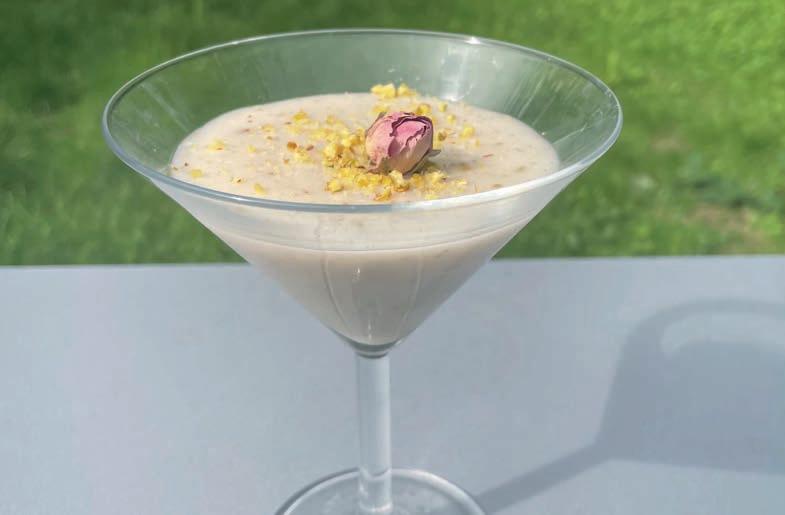
I have lived in Brent for 25 years. I am a Health Educator and a Healthy Walk Leader with a background in Nutrition & Dietetics and Complementary therapy. I love nature, creativity and like to look at things holistically. As a Nigerian woman, cooking is an acquired skill that has been passed over from generation to generation. I also help people understand that good nutrition is easy to achieve and it’s about building a good relationship with food and being mindful of the environment. Amala and Abula is a native dish of the Yorubas from the South West of Nigeria. It is a composite dish of fermented yam flour dough (swallow) served with two soups and stewed meat or fish.

I am a Yoruba woman from Ogbomoso Town. The indigenes are known to eat Amala and Gbegiri for breakfast and top it up with ogi (fermented corn meal). I was born in London, grew up in Lagos, the old capital city of Nigeria. My family usually travel to the home town during the holidays and I remember vividly that the morning
Obe Ata (stew)
Onion 150gms
1 Bell pepper
1 Scotch Bonnet Pepper
Tinned Tomatoes 150g
Rapeseed oil 4 tablespoons
Salt to taste
For the Gbegiri
Dehulled black eyed beans
50 grams
Water 2 cups
Pepper mix 1/2 cup
Iru (Locust beans) 5 grams
Bay leaf
Rapeseed oil 1 tsp
Vegetable oil two teaspoons
Salt to taste
was colder in Ogbomoso than Lagos. This dish restores warmth. In the morning, we go with our plates to buy the freshly prepared steaming hot Amala & Gbegiri with refreshing Pap. The heaviness of gbegiri and viscosity of the vegetable soup works very well with the bland taste of Amala. The pap had a distinct sour taste and contained no sugar. A portion of Amala was less than your fist. The stew was made with little oil and contained no meat. That was during the holidays.
Amala and Gbegiri connects me with my family roots - Ogbomoso. The place of birth of my parents; It’s restorative warmth combats the cold mornings of regional weather differences; a food in which I observed the influence of British culture on my father. He eats Amala with Fork and Knife. I should have asked him why as I still tuck into Amala with my fingers. Special thanks to my mum who taught me how to cook.
Ingredients (Serves 4)
For the Amala
Yam flour (elubo) 100 grams
Water 2.5 cups
Abula - Vegetable soup (Ewedu (Molokhia) and Efo Tete (Spinach)
Ewedu 150 grams
Efo Tete 50 grams
Iru 5 grams
Water 1 cup
Salt to taste
Preparation time: 45 minutes
Cooking time: 45 minutes
Why it’s good for the environment
The dish helps reduce waste by the fact that most of the ingredients used in the soup - the peppers and vegetables are from frozen packs. And the soup can be frozen to last a long time.
I would say the dish is good for the environment in that I have made it to be a vegetarian dish. I have replaced the meat with more Iru (locust bean) seed which is rich in protein combined with the bean curry. I have also introduced a second vegetable i.e. the spinach. Usually, it’s eaten with molokhia. Crayfish can be added for people that eat fish as an option.
Blend together peeled onion, bell pepper, scotch bonnet pepper with a cup of waterthis is your pepper mix. Pour out half a cup of the mixture and set aside for Gbegiri.
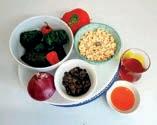
To the remaining mixture, add tinned chopped tomatoes and blend.
In a saucepan, bring to boil the pepper and chopped tomato mix and boil down until little liquid remains.
Stir in four tablespoons of rapeseed oil. Mix for 2 minutes.
Add 1/2 cup of water to reconstitute the pepper. Simmer for 2minutes.
Season with salt to taste.
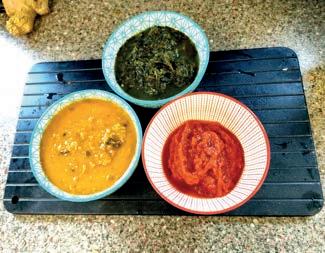
Soak brown eyed beans (50grm) for 30 minutes and dehull.
In a saucepan, add two cups of water, the dehulled beans and iru. Cook for 30 minutes until the beans become very soft. Mash to a puree consistency.
Add the half cup of pepper mix that was saved from the Obe Ata preparation.
Cook for 3 minutes. Add 1 teaspoon
rapeseed oil, one teaspoon of vegetable oil. Cook for two minutes.
Turn off the heat, Add the final one teaspoon of vegetable oil.
Season with salt to taste.
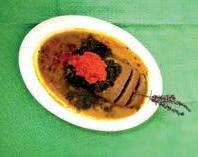
Bring water to boil. Stir in the Ewedu for 1 minute.
Stir in the Spinach.
Cook for 2 minutes.
Season with salt to taste.
Bring 2.5 cups of water to boil.
Stir in the elubo with the ladle and work it into a dough.
When ready, serve with Igbako (or a large spoon).

I’ve lived in Brent for over 23 years. Gujarati Indian by ethnicity, I have over 400 years of lacto-vegetarian ancestry. Having spent my childhood in Kenya, I have always been passionate about the environment, wildlife and good plant-based food. Understanding the destructive impact of animal agriculture on the environment, on animals and on humanity, my husband and I chose to go vegan. We started our Brent-based vegan catering and education business, called Shambhu’s, to educate the community about how fantastic, varied, nutritious and innovative the world of vegan food is. At its launch in 2005, Shambhu’s was the only exclusively vegan business in 2005, and is still among only a handful. I currently
also teach vegan cookery classes with Brent Start and at various organisations within and outside of Brent. For me, Pau Bhaji is a comforting/feel-good Indian street food classic. It is particularly popular during happy family get-togethers, and certainly revives many happy memories, with friends and family. Pau bhaji is a dish that is served at most Indian parties, pre-wedding celebrations and during festivals such as Diwali. And of course, although it’s an Indian dish, everyone can enjoy it, as it is very simple to make, very tasty, highly nutritious and very environmentally-friendly. You could say it’s an Indian version of “Sloppy Joes.”
4 sliced wholemeal burger buns /bread, or thick end bits / baguette slices etc*
Cumin powder
1 teaspoon olive oil or vegan spread
1 medium onion (red/white) or 1 leek (10cm)
2 cloves garlic
100g peas
100g carrots or 2 carrots
150g potato or 1 medium potato
80g cauliflower
Juice from half a lemon
2 tablespoons olive oil
Allergens: *Depending on bread/buns used: wheat gluten, sesame.
Fresh coriander (if available)
400g can chopped tomato
½ teaspoon cumin seeds
¼ teaspoon turmeric
¼ teaspoon cinnamon powder
¼ teaspoon clove powder
100ml water (if required)
½ teaspoon sugar or 15ml apple juice
Chilli flakes to taste
Salt to taste
Finely diced red onion and coriander leaves to decorate
This dish reduces food waste by using up vegetables that would otherwise have ended up in the bin/compost. The dish can also involve the use of the thick end parts of bread loaves to make croutons, or simply to use as the “pau” element of the dish. Bread ends, potatoes and tomatoes are amongst the most thrown away food items, and they can easily be incorporated with this dish.

As well as using up leftover veg, this dish is a practical and very tasty way to use up stale bread, rather than disposing of it. This dish is good for the environment in many ways:
• It is 100% plant-based.
• It can be made completely from locally-sourced or UK-grown vegetable ingredients, with only some of the spices that might come from outside the UK.
• The spiced vegetable mix is freezable for long-term storage.
Peel and thoroughly wash all the vegetables. Apart from the cauliflower and peas, dice all the vegetables into roughly ½cm squares. (You don’t need to be too precise.)
Cut the cauliflower into small pieces.
Either grate the garlic using the fine side of a grater or chop the garlic into tiny pieces.
In a saucepan, add the olive oil and heat gently.
When warm add the cumin seeds.
When the cumin seeds start to crackle, immediately add the onions/leeks and garlic.
Fry for a few minutes without burning the garlic.
Add the carrots, potatoes, peas, cauliflower and water.
Leave the mixture to boil. Give the vegetables a good stir and add water if needed.
Add the chopped tomato, spices and seasoning. Let the flavours blend together and leave to cook for another 8 -10 minutes.
Then use a potato masher to mash the vegetables. The consistency of the mashed vegetables should not be very runny. If there is too much liquid, evaporate it off on low heat but make sure the vegetable mash doesn’t stick to the pan. Taste the vegetable mash and add seasoning according to your taste.
Garnish with finely chopped fresh coriander and finely diced red onion.
Pan fry the buns/bread/etc in the olive oil or vegan spread.
Sprinkle a little cumin powder on each of the open sides of the half-buns/end-loaf pieces, or on one side of each bread slice.
Serve by spreading the vegetable masala on the bun halves or bread slices. The Pau Bhaji can be eaten like that, as open sandwiches, or if you prefer, made into closed sandwiches (with the masala as the filling).
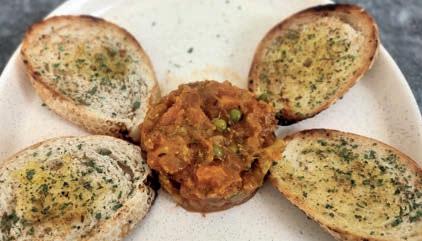
I am a retired widow with two grown up sons and 3 grandchildren, living in Roe Green Village, a conservation area of Brent. I have lived here since 1969 and love the area. I am passionate about not wasting food, having been brought up in the war years when rationing was a way of life. I also was a Secretary and helped my late husband in his electrical business. I usually make lots of soups, anyway, from leftover vegetables, but, this time, I have concocted a recipe which includes both vegetables and fruits, which is healthy and full of fibre.

Fresh Aldi Beetroot, including the stalks and leaves
Carrot
Courgette
Spinach leaves
Cucumber
Iceberg lettuce
Cauliflower
Beef tomato
Preparation time: 10 minutes
I try to use local retailers for this like MIR Food Centre in Kingsbury, but also my local Aldi and Asda. This dish is important to me because it brings back memories of sunny days as a child when my mother used to give us lots of good quality fresh fruit and vegs in spite of them being hard to get. Some of the produce used to be grown in our garden.
Strawberries
Blueberries
Kiwi fruit
Banana and nectarines
Fresh mint
Lemon juice
Coconut water
Greek Yogurt an optional extra
Get the remaining raw ingredients together and combine with cooked beetroot.
If you like a thicker, fibrous smoothie, add the stalks of the cauliflower and fruit peels. Fruit skins from the cucumber, bananas and kiwi fruit can hold lots of nutrients and the blender can change to a nice puree.
Add coconut water and lemon juice at the end to enhance the flavour.
Quantities have not been included by the chef to encourage readers to experiment with flavours and texture. If the beetroot taste is too strong, it can be watered down with coconut water or Greek yogurt for smoothie texture! Another reason for advocating this recipe, is that a lot of elderly people have problems chewing some vegetables or fruit, and this recipe makes it all possible. A blender also does not have to be expensive, but some have stronger blades than others. Mine is a basic Kenwood Jug Blender with three speeds.
Fruit and vegetables can deteriorate very quickly in the hot weather, so it is important to use these up as quickly as possible, hence putting any leftover ones in my blender! During the winter months, I would use most of the above in a soup. Even fruit can go into a soup, making it taste unique from other flavours. It is important to eat fruit and vegetables in season, but, again, buying them loose rather than in packaging. Market Stalls are good for this and also generally cheaper.
If you have any leftover fruit or vegetables try blending them to make a delicious juice or smoothie. Otherwise, any fruit and vegetables which are inedible can go in your food waste bin or at home compost bin.
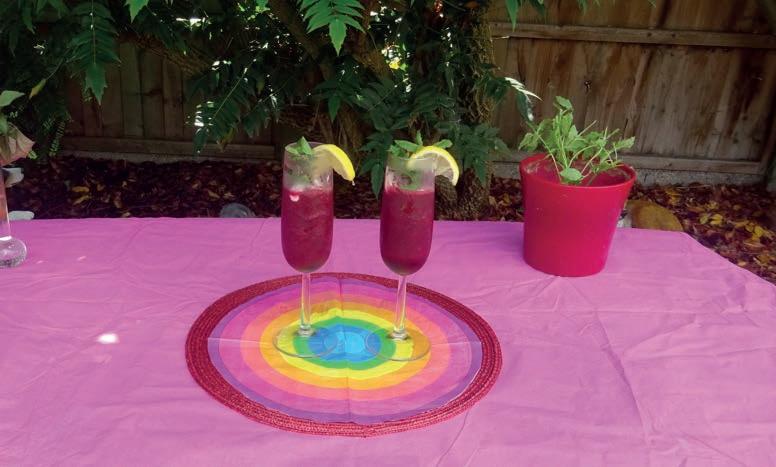
th ou g h t
From Brent to Bowl 39
I’ve lived in Brent for about ten years in Willesden Green and now in Stonebridge. I really like the borough, especially how diverse it is. I’m a stay-at-home dad for my two young sons - which means I need to do a lot of cooking! My wife is a superhero NHS nurse so I try to treat her to the best home-cooked food I can muster.
Whenever possible I like to cook with seasonal ingredients from around the UK. My favourite place to shop is Queens Park Farmers’
(Makes 4 servings)
For the blackberry compote:
400g blackberriespicked from your local park!
80g sugar
40ml water
For the set fool:

560ml milk*
50g caster sugar
50g cornflour
Allergens: *Contains milk
For the biscuits:
120g rolled (porridge) oats
80g demerara sugar
110g butter*
Zest of 1 lemon
For the garnish:
Lemon zest
Fresh blackberries
Fresh mint
Market where you are guaranteed that all the produce is in season and from UK farms. If you look around and try different things, you don’t always have to spend more than you would in a normal supermarket. I especially like finding ingredients I haven’t used before and trying out new recipes. I also like to take photos of the food I prepare and share them on Instagram @stephenhullfoodphoto.
Preparation time: 10 minutes Cooking time: 25 minutes
Start by making the blackberry compote. Wash the blackberries well and put them in a pan with the water and sugar, reserving some blackberries for the garnish. Cook on a low heat until softened but not completely broken down. Blitz in a blender until smooth. Chill.
For the biscuits, first mix the dry ingredients together. Melt the butter in a pan and pour it over the other ingredients. Mix well. Squash the mixture flat into a small, lined baking tin; or shape it into a rectangle on a silicone baking mat or baking paper. It should be about 6mm thick. Bake at 180°C for 12-15 minutes until golden. Allow it to cool in the tin, but slice it into individual biscuits while it is still warm because as it cools it becomes brittle.
Now make the fool. Mix a little of the milk with the sugar and cornflour. Boil the rest of the milk, and then pour it slowly onto the sugar and cornflour, mixing continuously. Return the mixture to the pan and allow to boil for a minute or two, stirring all the time. It should now be thick, like a Béchamel sauce. Chill.
Serve the dessert in glasses with the biscuits on the side. There are several ways to put the dessert together. You can mix all the blackberry compote and fool together; but it’s rather nice to spoon them into the serving glasses separately and then swirl them around to make pretty patterns. It’s also nice to add some fresh blackberries, mint, lemon zest and crushed up biscuits in each glass as you fill them to add flavour and texture. Alternatively, you can just garnish the top. Enjoy!
I think we should all try to reduce our energy consumption and food miles, and so I was excited to share this recipe using blackberries picked from parks around Brent. That’s not to say it’s perfect - it still has some ingredients from elsewhere - but the star of the show is both local and seasonal. What’s even better is you can pick blackberries across Brent’s parks for free! Go at the right time (August to September, but sometimes earlier and later too) and you can easily get bucketloads. They should be plump, juicy and dark in colour when you pick them. A little step and something to protect yourself from thorns is useful to get the hard to reach fruit. It’s also great for kids to get out and enjoy blackberry picking and learn about seasonal fruit and cooking.

Using wild fruit like this doesn’t just save you money: it reduces the need for additional farming and transportation of food. Young and old can have great fun going out and picking blackberries, saving them wilting and going to waste. It’s also a great way to engage children in learning about food, cooking and sustainability. Certainly it’s a highlight for my kids each year.
 From Brent to Bowl 41
From Brent to Bowl 41

I’m a GP living in Brent for the past 8 years. I am passionate about improving the lives of people in my local area and have volunteered with the local homelessness sector and mutual aid groups through the pandemic. I have two little girls, aged 2 and 5, who have inspired me to improve my cooking skills and repertoire and to make healthy meals and snacks for my family. I feel that healthy, affordable food should be accessible for all. I created this
(Makes 3-4 adult moulds or 8 mini moulds)
1 medium sized over ripe banana, roughly chopped 3 medium strawberries roughly chopped (optional)
125ml coconut cream
50 ml milk*
recipe as I was struggling to find healthy treats for my daughter one hot summer. Most supermarket lollies, even those aimed at children, have too much sugar to have regularly so I decided to create my own. These are completely free from any added sugar. The adults in our family enjoy them just as much as the little ones so we make them in both large and small moulds.
Allergens: *Contains milk
a tip
Preparation time: 10 mins (plus 4-6 hours freezing time)
Place all ingredients apart from milk into a blender (I use a hand blender with a jug which works well too). Blend until smooth, adding the milk as needed a little at a time to keep a thick consistency - you probably won’t need all of it. The mixture should pour very slowly and be spoonable. If you need to thicken it, add extra banana.
Pour or spoon into your moulds and put the moulds into the freezer.
Leave to freeze for 4-6 hours or overnight. Remove from the moulds once frozen and enjoy!
Try replacing the strawberries with other berries, fruit or even some types of veg. You can even rescue discounted short date fruit from the supermarket. More unusual ingredients we have tried:
a. Indian mangoes in season from Ealing road
b. Avocado
c. Small quantity steamed carrots or beetroot (they give a lovely vibrant colour and added vitamins as a bonus
I have used whole cow’s milk in this recipe but this can be replaced with any plant based milk to make it vegan.
You could also experiment with various flavourings for the lollies - add very sparingly. Rose and vanilla both work well for the recipe above.
These are frozen lollies made with over ripe bananas and any berries or other fruit which are nearing their expiry. No cooking is required - they are blended with coconut cream and a little milk and poured into the mould and frozen.
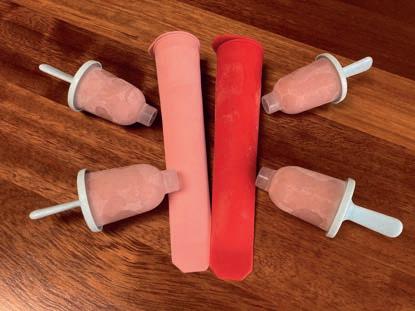
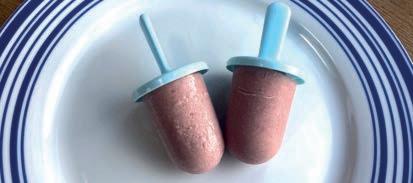
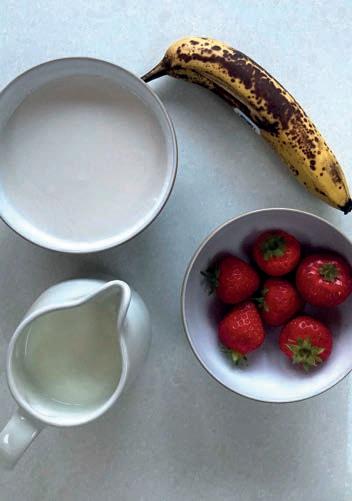
More than half a million tonnes of dairy products are wasted every year! So if you’re not sure what to do with your milk, then this is your recipe!
From Brent to Bowl 43
We’ve lived in Brent now for over 12 years. We chose Willesden Green to live in because of its multi-ethnicity and easy access to London where I used to work. Unfortunately, I am disabled which limits what I can do, however now that I’m retired I read and review books and have become a keen gardener and we open our garden for charity. My work life was all about sharing and managing knowledge.
My husband and his family came from Dorset, and lived and farmed there for generations. This Dorset recipe was passed down to my Mother-in-Law from
300g apples (or other fruit), of any variety with or without peel as preferred, chopped up about 1 inch cubes
300g self-raising flour - either white, or a mix of 50/50 brown and white (or other combination to taste). All brown makes the cake too heavy. Finer flour will make the cake lighter.
150g unsalted butter*
1 large egg*
150g sugar - brown / raw cane are best to add flavour, plus an extra for sprinkling
75g sultanas or currants
Milk as required*
Pinch of salt
hers, and when I first married she passed it down to me as I never used to know how to make cakes. It is a firm favourite with the family whether served as a cake or a pudding. Delicious with clotted cream or ice-cream, it has the great benefit of being very adaptable to whichever fruit you have in abundance, whether apple as in the original, or blackberries foraged from the hedgerows, or any berry you grow. It freezes well and becomes a useful addition to the emergency visitor stash!
Preparation time: 15 minutes Cooking time: 45 minutes
Preheat the oven to 180oC.
Cut your room temperature butter into small chunks; (make sure your hands are cold or chilled).
Rub the butter and flour together until it forms breadcrumbs.
Add the egg, fruit and sugar and a pinch of salt (lo-salt is acceptable) and mix with a fork. Add milk until it begins to stick together like a dough, not so that it is a paste.
Scrape into your pre-buttered serving dish - I use a long shallow roaster 15cmx28cm).
Smooth out the surface - note the fruit will stick through the batter - and sprinkle a small amount of sugar on top for crunch.
Cook on the middle rack in the oven at 180oC for 45 minutes. Ensure that a testing probe comes out clean. Note that you can use small dishes to make a deeper cake which will take longer to cook.
Serve warm with cream, ice-cream or just butter on top.
Allergens: *Contains milk, eggs
This cake/pudding is infinitely variable to any berry or fruit grown in an English garden. It is perfect for those apple or pear fallers, and ensures that berries which come in abundance all at one time can be used up before they go off. It can be batch baked easily and freezes well.

1Our waste, our resources: A strategy for England: https://assets.publishing.service.gov.uk/government/uploads/system/uploads/attachment_data/file/765914/resources-waste-strategy-dec-2018.pdf
In the UK, the carbon footprint of food and drink consumed is estimated to be equivalent to one fifth of UK emissions1



I’ve chosen this particular recipe for you try and I am sure you will enjoy creating this beautifully fragrant cake as much as I have. Ras malai is Bengali for ‘juice creams’. They are these little bits of cake that bob around in gently spiced milk, like a floating cheesecake thing. This is my version of this traditional Bengali recipe, without the floating. It has the same delicious flavours – rich, creamy and lightly spiced and fragrant.
10 strands of saffron dropped into
4 tablespoons of warm milk
250g unsalted butter
250g caster sugar
5 medium eggs, beaten
250g self-raising flour
1 teaspoon baking powder
Preparation time: 1 hour
Preheat the oven to 170°C/fan 150°C. Grease and line two 20cm sandwich tins.
For the milk drizzle
100g milk powder
150ml boiling water
Cardamom seeds, removed from the pods and ground
For the buttercream
2 cardamom pods, crushed
3 tablespoons whole milk
300g unsalted butter,softened
600g icing sugar, sifted
Make the saffron milk. Place the butter and sugar in a bowl and whisk until light and fluffy and almost white. Add the eggs a little at a time, making sure to keep whisking. Then add the flour, baking powder and saffron milk, and fold the mixture until you have a smooth, shiny batter.
Divide the mixture between the two tins and level the tops. Bake for 20–25 minutes. Meanwhile, make the milk drizzle by mixing the milk powder with the boiling water in a bowl. Add the ground cardamom seeds and mix. As soon as the cakes are out of the oven, drizzle some of the milk all over the top of both cakes and leave in the tin for at least 10 minutes before turning them out and removing them to cool on a rack.
To make the buttercream, put the crushed cardamom pods in a small bowl of the milk and leave to infuse.
Allergens: *Contains milk, eggs, gluten
Meanwhile, put the butter into a mixing bowl and whisk until very soft and light in colour. Add the icing sugar a little at a time, whisking after each addition, until all combined. Then pour the cardamom milk through a sieve into the buttercream and whisk until really light and fluffy.
Once the cakes are totally cool, place one cake on your serving dish and spread an even layer of buttercream over it. Put the other cake on top. Flip the cake over so the milk drizzle top becomes the bottom and sandwiches the buttercream. Spread some buttercream evenly across the top and the sides and use a ruler to level off the edges.
If you have any cream left over you can pipe little kisses on top. Then gently take the rose petals and pistachios and press them into the bottom edge of the cake.

I always combine ingredients and methods of cooking from different cultures. There are no rules to my cooking! I also hate food waste. The only food waste in this Ras Malai cake are the eggshells... and even those don’t go to waste either - I always find a use for them!
From Brent to Bowl 47 Recipe Credit: Time to Eat (Michael Joseph £22) by Nadiya Hussain. Photo Credit: Chris TerryFrom Brent to Bowl is a sustainable community cookbook brought to you by Veolia and Brent Council. The book brings together the Brent community to celebrate our cultural and culinary diversity with a focus on providing education on sustainable eating. Every recipe has been submitted by Brent residents, and by sharing them with you we hope to spread good cooking practices to Brent and the planet.
A very special thank you to each of the 20 cooks who have contributed to this book, Asma Khan for her inspirational foreword and Nadiya Hussain, winner of the Great British Bake Off, who kindly donated a recipe and supports our cause to fight food waste whilst celebrating our borough’s diversity.